Accessible, accurate, and reliable data are at the heart of data-informed decision-making. At Ball State University, Data Cookbook plays a crucial role in this process, serving as a central hub for data governance and ensuring consistency across institutional analysis and analytics efforts. It allows departments to work from a unified business glossary, improving decision-support and shared understanding. We sat with Cole Heady, the Director of Decision Support, to explore what Data Cookbook does, how it functions, and why it matters to his office and the institution more broadly.
What is Data Cookbook?
Data Cookbook is a centralized data governance system that facilitates conversations regarding data definitions, specifications, and institutional policies. It provides an organized and shared approach to overseeing data definitions, schemas, and lineage, supporting accountability, and aligning the data warehouse with Ball State‘s strategic goal 5i, which aims to ensure that:
Campus administrators use data analytics and robust management information to provide actionable insight that enhances student success and administrative effectiveness.
“Data Cookbook is the framework in which we talk about our data at the institution. It gives us a common language to have discussions about how we ought to be dealing with our data successfully,” the director said. An example of this is the definition of terms like ‘retention,’ which may have different meanings from department to department. Data Cookbook standardizes such definitions so that there is clarity and consistency. Below you can see a high-level overview of the app and how many definitions exist (most waiting in the draft stage right now).

Screenshot of the Data Cookbook App, available here for BSU staff Data Cookbook
How Does It Support Institutional Goals?
At Ball State, Data Cookbook supports decision-making by having business glossary definitions well-defined and readily accessible. Prior to its implementation, important information about data was trapped in the minds of individual power users, with potential for information loss when they left the university. Now, with a formal and documented repository, institutional knowledge is captured and accessible to all.
“It‘s like a cookbook,” the director explained. “Just as a cookbook has recipes handy for future use, Data Cookbook has data governance processes documented and ready to go.”.
The Data Flow: From Collection to Use
Ball State data governance begins with the data that is created in various source systems. It is then transported to the data warehouse and finally makes its way to dashboard analytics, primarily in Tableau. From there we follow a set of defined steps:
- Definition & Specification: Terminologies and data specifications are defined by subject matter experts.
- Internal Review: Then, these definitions are reviewed by the Institutional Research and Decision Support (IRDS) team.
- Data Governance Subcommittee Review: After the IRDS team review, it goes to the Data Governance sub-committee for further review.
- Approval & Implementation: Afterwards, the terminologies and definitions are approved by MIDAS and they are then officially available for institutional use.
This standard workflow, example below, ensures transparency and it’s flexible, which gives room for versioning and updating as and when needed.
Who Uses Data Cookbook?
Currently, the primary users of Data Cookbook are data analysts and Tableau users who require accurate data definitions for their activities. However, Ball State plans to expand its use in several departments, integrating it into more business processes and technical documentation. As part of this effort, we have worked with both iData and our Heliocampus partners to make sure that direct links from Tableau to Data Cookbook become available on more of our dashboards (as seen below in one of our Core dashboards).
How is the Data Accuracy and Relevance Maintained?
It’s a continuous validation and monitoring process to ensure the accuracy of the data. IRDS engages users who interact with data on a day-to-day basis, raising anomalies and questioning discrepancies. “Sometimes a figure comes out high, and we take it back to the experts and ask them why. It‘s a detective activity that enables us to distinguish between expected variation and real anomalies,“ the director added.
Who is in charge of Training and Support?
Institutional Research and Decision Support (IRDS) provides regular training for new users, which includes training in data governance and best practices. This initial training is required for all new users before access is granted to Tableau. We also have an ongoing monthly training for all Tableau users that is conducted by the Office of Decision Support.
What do you think of the future of AI and Data Cookbook?
As AI and machine learning continue to redefine the world of data, their role in governance is also coming into focus. While AI excels at processing large volumes of data and making predictions, human oversight remains crucial. AI provides insights from its training data, but it may misinterpret how critical business definitions are used at BSU if governance systems are absent. Data Cookbook provides the semantic layer needed to ensure AI-generated data adheres to institutional definitions.
Conclusion
Data governance at Ball State is evolving, and Data Cookbook plays an essential role in this transformation. Through a centralized and structured approach to data management, the university ensures that data-informed decisions are based on consistent data that aligns with institutional definitions. As technology advances, Ball State continues to refine its data governance strategies to foster transparency, collaboration, and innovation.
Discover more from Data Insider
Subscribe to get the latest posts sent to your email.



